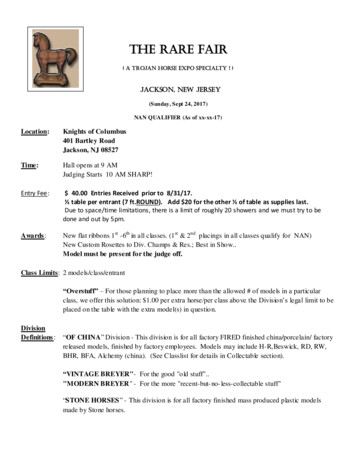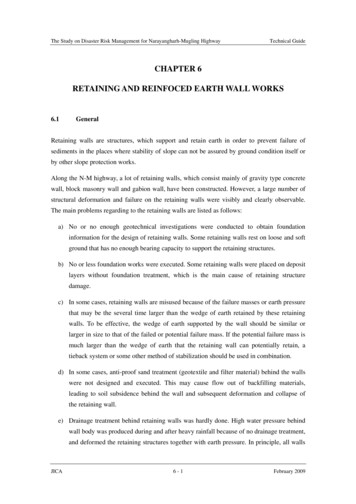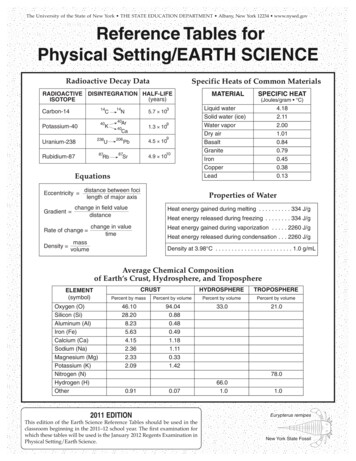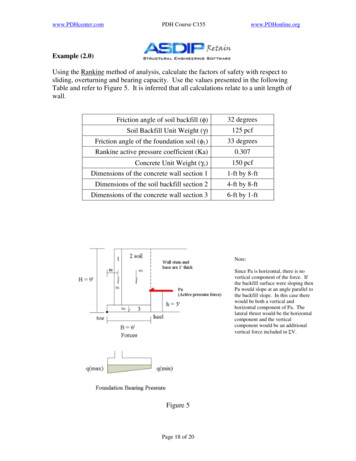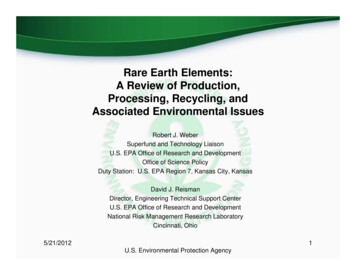
Transcription
Rare Earth Elements:A Review of Production,Processing, Recycling, andAssociated Environmental IssuesRobert J. WeberSuperfund and Technology LiaisonU.S. EPA Office of Research and DevelopmentOffice of Science PolicyDuty Station: U.S. EPA Region 7, Kansas City, KansasDavid J. ReismanDirector, Engineering Technical Support CenterU.S. EPA Office of Research and DevelopmentNational Risk Management Research LaboratoryCincinnati, Ohio5/21/20121U.S. Environmental Protection Agency
Presentation Outline Introduction to the Rare Earth Elements Why are we interested in them and where are they found in the US? How are they acquired and what are potential environmental impacts? What are the emerging policies and alternatives to REEs? ORD NRMRL ETSC Technical Support Publication Document Key Findings and Next Steps of the Document Where to go for more information5/21/2012U.S. Environmental Protection Agency2
Introduction to the Rare Earth ElementsPowders of six rare earth elements oxides. Photograph byPeggy Greb, Agricultural Research Center of UnitedStates Department of Agriculture.5/21/2012 15 lanthanides La through Lu– Pm is rare in nature – mostlyhuman-made Plus scandium and yttrium are oftenincluded a.k.a. Rare Earth Minerals, Oxides,and/or MetalsU.S. Environmental Protection Agency3
Introduction to the Rare Earth ElementsWikipedia photo Assortment of lanthanoide group elements.Uploaded at 22:12,19 April 2006 by User:Tomihhndorf. AuthorUser:Tomihahndorf. Permission GFDL.ScandiumYttriumWikipedia photo Gibe,free documentation licenseWikipedia photo Tomihahndorf,free documentation licensePeriodic table of the elements showing the division betweenLREEs and HREEs (Schuler et al., 2011).5/21/2012U.S. Environmental Protection Agency4
Introduction to the Rare Earth Elements Similar chemical properties– Electropositive (valence 3 ) – Ce4 and Eu2 also in natural systems– Differ from other metals (Valence located in inner 4f subshell orbital, shielded by 5s2and 5p6 outer closed (full) subshells)– Stable outer shell results in very similar chemical properties and difficulty in theirseparation during processing– Atomic nucleus is poorly shielded and with increasing atomic number, 4f shell electronspulled closer to the nucleus Reduction in the ionic radii with increasing ionic charge– Lanthanide Contraction Not really rare – term stems from 1940’s/50’s Don’t occur as native elemental materials– Host mineral’s chemistry– Bastnasite, Monazite, Xenotime, and others5/21/2012U.S. Environmental Protection Agency5
Introduction to the Rare Earth ElementsAbundance of Elements in the Earth’s CrustCrustal Abundance(parts per million)ElementsNickel (28Ni)Zinc (30Zn)Copper (29Cu)Cerium (58Ce)aLanthanum (57La)Cobalt (27Co)Neodymium (60Nd)Yttrium (39Y)Scandium (21Sc)Lead (82Pb)Praseodymium (59Pr)Thorium (90Th)Samarium sGadolinium (64Gd)Dysprosium (66Dy)Tin (50Tn)Erbium (68Er)Ytterbium (70Yb)Europium (63Eu)Holmium (67Ho)Terbium (65Tb)Lutetium (71Lu)Thulium (69Tm)Silver (47Ag)Gold (79Au)Promethium (61Pm)Crustal Abundance(parts per -18Lanthanides (lanthanoids), scandium, and yttrium are presented in boldface type.(Adapted from Wedepohl, 1995)5/21/2012U.S. Environmental Protection Agency6
Why are we interested in them? Used in all types of modernelectronics and green technologies Foreign sources have 95 to 97percent of the world’s current supply Make very light and strongpermanent magnets, alloys,batteries, catalysts,lighting/displays, lasers, windturbines, solar panels, etc. Limited number of currentlydeveloped US sources5/21/2012U.S. Environmental Protection Agency7
Why are we interested in them?Rare Earth Elements and Their iumNeodymiumPromethiumApplicationsElementMetal alloys for the aerospace industry.Ceramics, metal alloys, lasers, fuel efficiency, microwavecommunication for satellite industries, color televisions, computermonitors, temperature sensors. Used by DoD in targeting and weaponsystems and communication devices. Defined by DOE as critical in theshort- and mid-term based on projected supply risks and importance toclean energy technologies.Batteries, catalysts for petroleum refining, electric car batteries, hightech digital cameras, video cameras, laptop batteries, X-ray films,lasers. Used by DoD in communication devices. Defined by DOE asnear critical in the short-term based on projected supply risks andimportance to clean energy technologies.Catalysts, polishing, metal alloys, lens polishes (for glass, televisionfaceplates, mirrors, optical glass, silicon microprocessors, and diskdrives). Defined by DOE as near critical in the short-term based onprojected supply risks and importance to clean energy technologies.Improved magnet corrosion resistance, pigment, searchlights, airportsignal lenses, photographic filters. Used by DoD in guidance andcontrol systems and electric motors.High-power magnets for laptops, lasers, fluid-fracking catalysts. Usedby DoD in guidance and control systems, electric motors, andcommunication devices. Defined by DOE as critical in the short- andmid-term based on projected supply risks and importance to cleanenergy technologies.Beta radiation source, fluid-fracking nsHigh-temperature magnets, reactor control rods. Used by DoDin guidance and control systems and electric motors.Liquid crystal displays (LCDs), fluorescent lighting, glassadditives. Used by DoD in targeting and weapon systems andcommunication devices. Defined by DOE as critical in theshort- and mid-term based on projected supply risks andimportance to clean energy technologies.Magnetic resonance imaging contrast agent, glass additives.Phosphors for lighting and display. Used by DoD in guidanceand control systems, targeting and weapon systems, andelectric motors. Defined by DOE as critical in the short- andmid-term based on projected supply risks and importance toclean energy technologies.High-power magnets, lasers. Used by DoD in guidance andcontrol systems and electric motors. Defined by DOE as criticalin the short- and mid-term based on projected supply risks andimportance to clean energy technologies.Highest power magnets known.Lasers, glass colorant.High-power magnets.Fiber-optic technology, solar panels, alloys (stainless steel),lasers, radiation source for portable X-ray units.X-ray phosphors.(Adapted from US DOE, 2011)5/21/2012U.S. Environmental Protection Agency8
Where are they found ? Everywhere,-But for economic deposits, see the following map5/21/2012U.S. Environmental Protection Agency9
Where are REE deposits found in the US?Map showing occurrences of REEs, by rock type (adapted from multiple sources, seeAppendix B of EPA ORD NRMRL ETSC REE document)5/21/2012U.S. Environmental Protection Agency10
How are they acquired? Mining? Mining – Surface or underground operations with associated surface tailings,impoundments, and processing facilities, etc. Resource extraction and processing (hard rock example)– Mining Overburden, Waste Rock, Sub-Ore, and Ore –Beneficiation Grinding, flotation, thickening, separation, drying –Ore - up to 13 percent REE or greaterTailings - up to 0.5 percent REE or greaterResults in a mineral concentrate – up to 60 percent or greater REOExtraction Hydrometallurgy, Electrometallurgy, and/or Pyrometallurgy Separates individual REOs from the mineral concentrate––Liquid-liquid extraction, solid-liquid extraction, solid phase, ion exchange, supercritical extraction, electrowinning,electrorefining, or electro slag refiningReduction for high purity rare earth alloys Smelting (metallothermic reduction) is the most widely used method where reductants react in a furnacewith oxidants (oxygen, sulfide, carbonate) to separate and free metalThree primary methods to produce REMs Reduction of anhydrous chlorides or fluorides, reduction ofrare earth oxides, fused salt electrolysis of rare earth chlorides or oxide-fluoride mixtures–5/21/2012Several other less common processesU.S. Environmental Protection Agency11
How are they acquired? Recycling? Collection––– Dismantling/Preprocessing(Separation)–– Manual or mechanical separation or disassembly, mechanical shredding, and screeningHazardous substances ( lead, mercury, other metals, flame retardant resins) and ozone-depletingsubstances may need to be managed at this stageProcessing– As of May 2011, 25 state laws require e-waste recycling and 5 states are pendingNationally, 19 percent of consumer electronics were recycled in 2009EPA’s Plug-In to eCycling Website includes links to take-back and drop-off locations Partners include retails stores, equipment manufacturers, and mobile device service providers– 68 million lbs of consumer electronics were collected and recycled in 2008Pyrometallurgy, hydrometallurgy, electrometallurgy, tailings recycling, dry processes using hydrogengas (research stage), titanium dioxide process (research stage). microbe-filled capsule technology(research stage)Commercial REE Recycling applications–5/21/2012Number of operations is limited based on a literature review – most are in R&D stage Air conditioners, Washing machines, Hard Disks, Mine Tailings, Batteries, ElectronicsU.S. Environmental Protection Agency12
What are the Potential Environmental Impacts? Contaminants of concern including metals - will be dependent on the REE-bearing ore,the toxicity of the contaminants from the waste rock, ore stockpiles, and process wastestreams–Mobility of the contaminants will be controlled by geologic, hydrologic, and hydrogeologicenvironments where the mine is located along with the characteristics of the mining process andwaste handling methods.–Urban mining and/or recycling operations will likely be similar to mineral processing since recoveryand refining methods will likely be identical Radionuclides – are often associated with REE deposits including thorium and uranium REEs –EPA has conducted an IRIS assessment for cerium (2009) and PPRTVs for gadolinium (2007),lutetium (2007), neodymium (2009), praesodemium (2009), promethium (2007), samarium (2009) ––Limited information at this time to assess carcinogenic potentialEPA has not yet reviewed the toxicity of lanthanum, europium, terbium, dysprosium, holmium,erbium, thulium, ytterbium, scandium, or yttriumSelect toxicological and epidemiological data with respect to REEs are published by others in theliterature5/21/2012U.S. Environmental Protection Agency13
What are the Potential Environmental Impacts?ActivityEmission Source (s)Mining (abovegroundand undergroundmethods)OverburdenWaste RockSub-ore StockpileOre gs ImpoundmentLiquid Waste fromProcessingRecyclingCollectionDismantling and SeparationScrap WasteLandfillProcessing5/21/2012Primary Pollutants of ConcernRadiologicalsMetalsMine Influenced Waters/Acid MineDrainage/Alkaline or neutral minedrainageDust and Associated Dust and Associated PollutantsTransportation PollutantsDust and Associated PollutantsVOCsMetalsOrganicsDust and Associated PollutantsVOCsDioxinsMetalsOrganicsU.S. Environmental Protection Agency14
What are the Emerging Policies & Alternatives to REEs? Emerging Policies/Programs to support REE recycling–––– A Number of Relatively Recently Introduced Congressional Bills, etc. (2010 and 2011) Re-establish domestic REE industry Prohibit export of certain electronics waste Modernize US policies related to production, processing, manufacturing., recycling, and environmentalprotection – focused on minerals for military security and strong economy Direct DOI to conduct research related to ensuring the supply of critical materials throughout the supplychainDOE ARPA-E - 30 million in funding to Rare Earth Alternatives in Critical Technologies (REACT)UN – With 2.5 million in funding from EPA, will track discarded mobile phones and electronic wastesgenerated in the US to develop solutions aimed at recovering REMs – the project includes other internationalpartnersNSF-funded Center for Resource Recovery will develop technologies for greater scrap utilizationAlternatives to REEs–5/21/2012Research Magnets– Iron nitride, ferrite, alnico-iron alloy family, iron-cobalt based alloys, and nanostructuredcompounds– Neodymium-iron-boron magnets using less REE and producing less hazardous byproducts Electronic displays - Single-atom-thick sheets of carbon and carbon nanotubes Solar Cells - Copper, zinc, tin, and sulfurU.S. Environmental Protection Agency15
The ORD NRMRL ETSC DocumentProject concept discussed on November 18, 2010 atan EPA Technical Support Project meetingORD NRMRL ETSC assembled a technical supportdocument development team that participated inmonthly calls through September 2011Internal EPA review leading to a technical supportpublication by ORD NRMRL ETSC in 20125/21/2012U.S. Environmental Protection Agency16
Key FindingsSelect Key Findings Analysis of the future supply and demand for each of the REEs indicates that by 2014, global demand couldexceed 200,000 tons per year – which would exceed current production by 75,000 tons per year The waste footprint and environmental impacts from mining to extract REE mineral ores are expected to beas significant as current metals/minerals mining practices. The most significant impact from contaminantsources associated with hard rock mining is to surface water and ground water. AMD is not usually asignificant issue for REE deposits given their common occurrence with carbonate minerals – however therock that surrounds or is overlying an ore body may contain sulfide minerals that could create AMD Rare earth milling and processing is a complex, ore-specific operation that has potential for envi
Wikipedia photo Gibe, free documentation license. Yttrium. Wikipedia photo Tomihahndorf, free documentation license. Periodic table of the elements showing the



